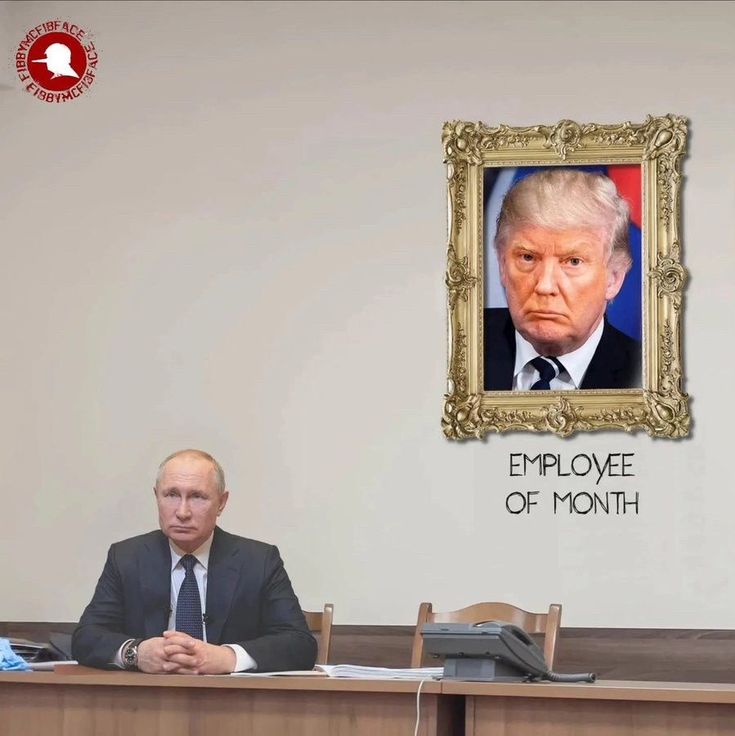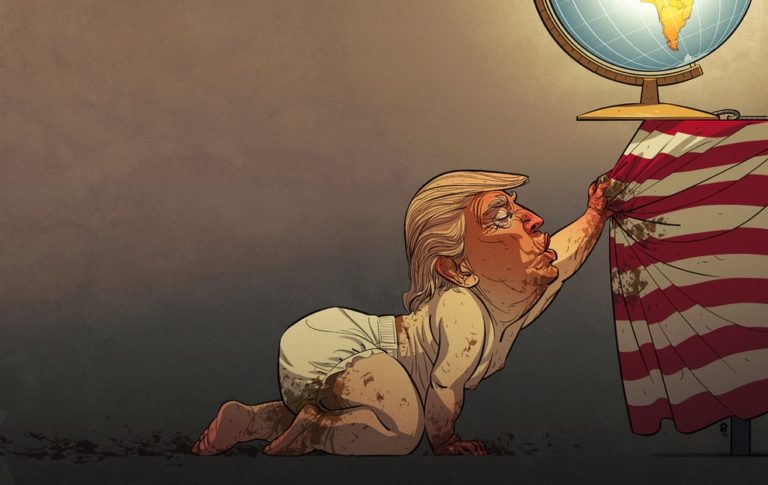Buy American! I did. Donald Trump is the best purchase I ever made. – Vladimir Putin


Of course, Trump spared Putin’s Russia and Belarus from tariffs
Eric Strikwerda, Athabasca University
During Donald Trump’s first term as president, the United States lurched from the absurdity of his lies to the use of his office for personal financial gain, his schoolyard insults, and his utter contempt for critics. His term ended with his irresponsible and dangerous incitement of the assault on the Capitol building on Jan. 6, 2021.
This time around, Trump is relying on outdated tools — tariffs, small government, territorial expansion, and nationalism — to solve modern problems of globalization, wealth disparities, the decline of manufacturing jobs, and exploitative capitalism.
On April 2, he announced a baseline tariff of 10 percent on all imports that aren’t compliant with the Canada-United States-Mexico Agreement. Canada has also been hit with a 25 percent levy on Canadian-made automobiles.
The Trump administration’s current use of 19th-century tools to solve 20th-century problems that are wholly inappropriate for the 21st century threatens to return America to the 19th century. This is an incredibly dangerous road for the U.S. to take.
The rise of the nation state
The 19th century was marked by the rise of the nation-state — a single political entity united by geography, culture, and language.
In many respects, this resulted from the rapidly industrializing world shifting away from monarchical rule and mercantile economics toward limited democratic rule and free-market capitalism.
It was a time of tariffs, small government, territorial expansion, and nationalism. It was also a time of mass migration from Europe to North America, where rampant nativism, colonialism, and unchecked and exploitative capitalism shaped the landscape.
The prevailing belief at the time was that nation-states should use tariffs, adopt isolationist policies to cut off the outside world, and seize territory where possible. These measures, it was thought, would foster national unity and allow capitalism to thrive by letting the “invisible hand” of the marketplace work its magic.
Protective tariffs promised to grow domestic industries, but the economic benefits were not evenly distributed. Wealth disparities grew wider as millions of immigrants arrived on North American shores, only to find deplorable living conditions in the cities and hardscrabble farmland out in the country.
Some newcomers prospered, of course, but they tended to arrive with money already in their pockets. And they quickly learned how to exploit the lack of state-directed regulation, patches of corruption amid rapid Western expansion, and growing nativism and poverty to their own benefit.
Many of the 20th century’s problems flowed from these 19th-century trends.
The economic fallout of tariffs
Following the financial Panic of 1873 and its ensuing economic depression in Europe and North America, nation-states unleashed tariffs to protect their domestic economies. It was the wrong strategy to pursue, as it slowed trade even more by limiting the free flow of goods and capital. Money, as is now well-known, needs to move to grow.
Working families chafed at the lack of labour protections like bargaining rights, health and safety measures, unemployment insurance, and sick benefits. In response, they formed unions and initiated waves of strikes throughout the western industrialized world.
Western North American farmers were furious that tariffs forced them to buy on protected markets while selling on unprotected ones, subject to international market prices. To protect their interests, they organized by forming farmer co-operatives and backing movements like the Granger movement, populism, and progressivism.
Nation-states, warmed by rising nationalist fires, formed military-defence alliances across Europe and its colonial and former colonial holdings, including Canada. In 1914, these alliances led to the First World War, a global and industrial war that the world had never seen.
The Great Depression
By the 1930s, unrestricted and largely unregulated capitalism, astonishing wealth disparities, and monopolistic tendencies plunged the world into the decade-long Great Depression.
Many governments’ initial response was to impose tariffs once again, and just as in 1873, they only worsened the problem. The simultaneous rise of fascism, which was essentially nationalism run amok, brought the world to war again at the end of the decade, to devastating consequence.
The post-war years saw a concerted international effort to use the nation-state to regulate domestic economies by investing in social services and programs and reining in runaway capital when its excesses threatened stability.
International bodies like the World Bank, the United Nations, and the International Court of Justice were created to promote peace and stability. This new approach wasn’t always successful in its goals, but the world hasn’t seen any global hot wars or massive economic depressions.
The end of history
In 1992, historian Frances Fukuyama infamously declared that the world had reached “the end of history.”
He didn’t mean that time stopped, of course. Instead, he argued that the liberal nation-state represented “the end-point of mankind’s ideological evolution and the universalization of western liberal democracy as the final form of human government.”
In his view, the Western industrialized world had reached the pinnacle of successful governance and unlimited prosperity.
Yet, even as Western liberal democracy congratulated itself on its success, these same nation-states, in conjunction with large corporations, were seeking lower labour costs and greater profit in the developing world.
The result was a hollowing out of North America’s industrial heartlands and rampant exploitation of vulnerable labour in places like Asia, South Asia, and South Central America. Once mighty American cities declined. Wages failed to keep up with inflation. Farm debt soared.
This is where the Trump administration re-enters the story — tapping into the frustration and disillusionment of frustrated Americans by promising to restore a “golden age” that never was.
Trump’s 19th-century playbook
Despite his promises, Trump’s tariffs will unlikely bring manufacturing jobs back to the U.S. As history has shown, tariffs do not revive already gone industries; instead, they will only make Americans pay more for the things they need.
Returning to small government won’t “make America great again,” either. Instead, it risks repeating the 19th-century pattern of making the rich richer and gutting the very social programs millions of people rely on. The Trump administration’s massive and ongoing cuts to the Social Security Administration are already well underway.
Trump’s rhetoric about territorial expansion, including threats to annex Greenland and Canada, won’t make the U.S. more secure. It will exacerbate the international tensions the world saw in 1914 and 1939.
And with limited resources left to exploit, it’s becoming harder for capital to sustain itself, even as it seeks to wrest whatever is left from our planet, the realities of environmental catastrophe be damned.
Nationalism, meanwhile, won’t foster a sense of national unity. It will only deepen existing divisions based on race and class. And if history is any guide, the consequences could be even more dire this time around, even pushing the world toward a global conflict unlike anything seen before.![]()
Eric Strikwerda, Associate Professor, History, Athabasca University
This article is republished from The Conversation under a Creative Commons license. Read the original article.




Comments are closed.